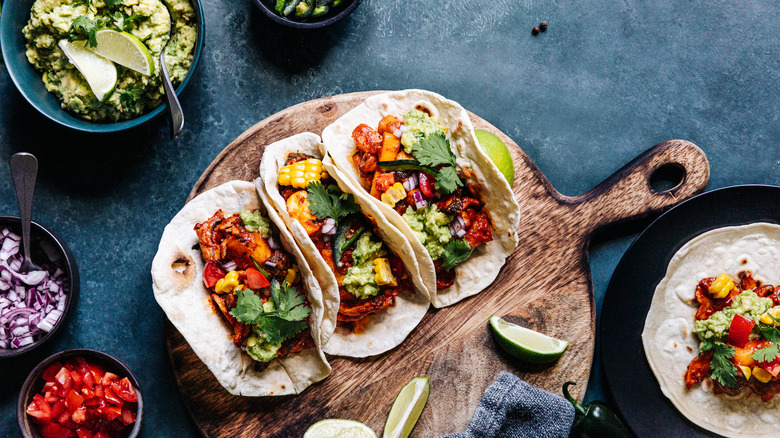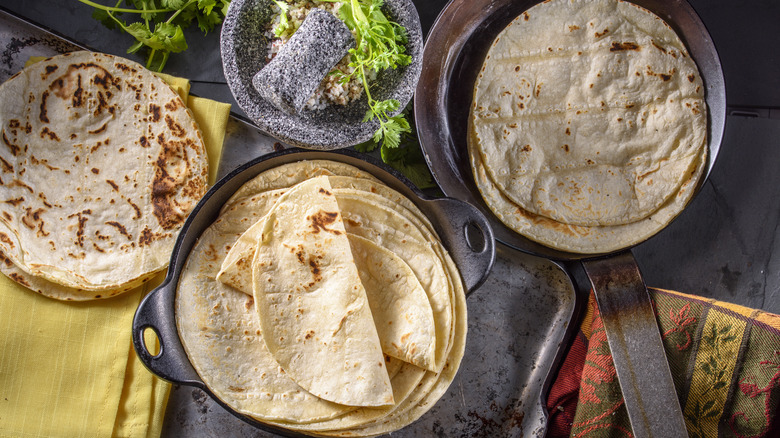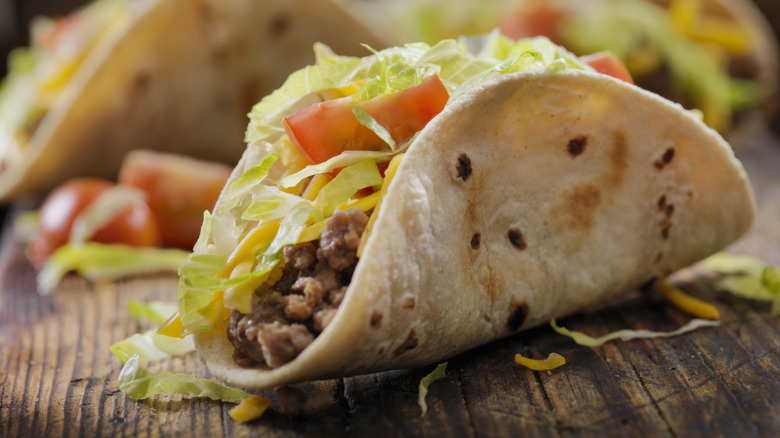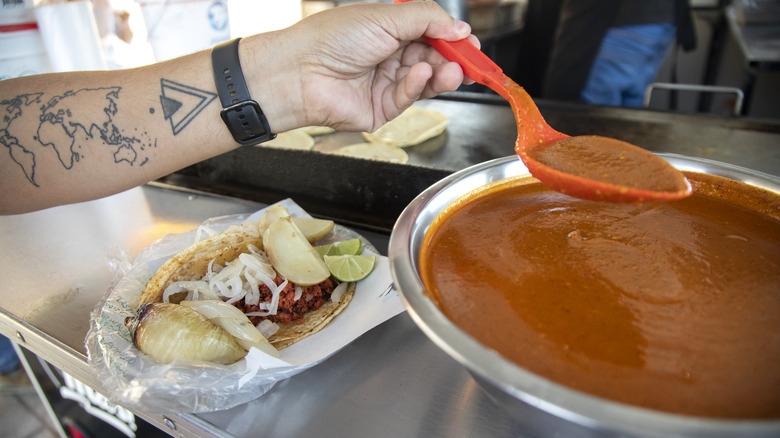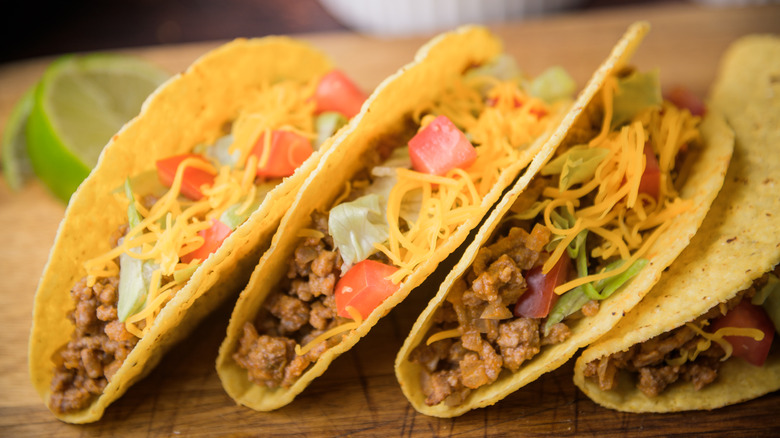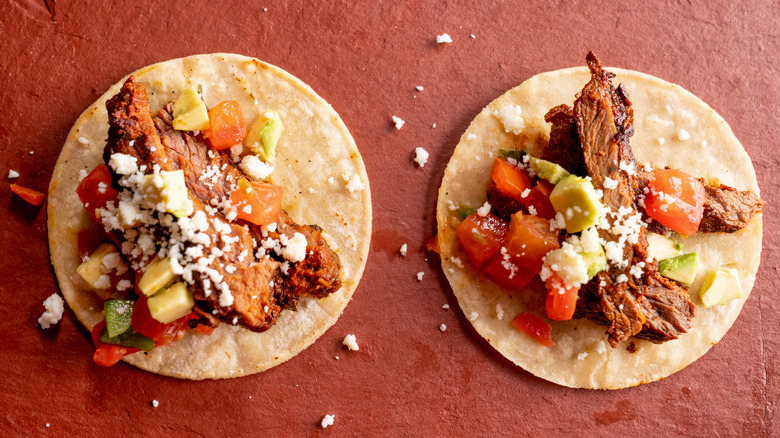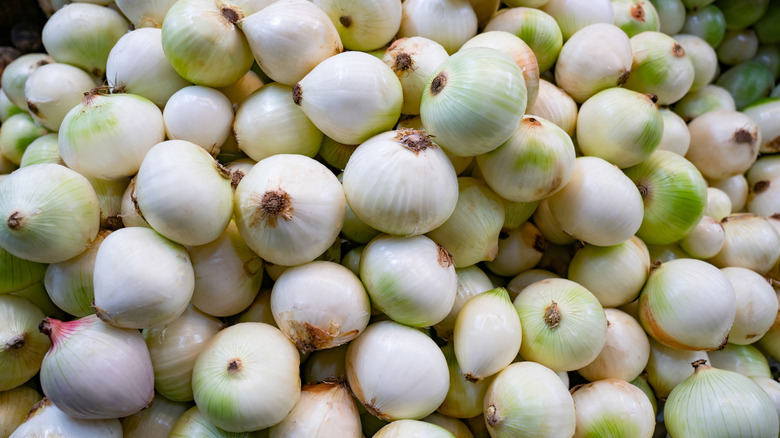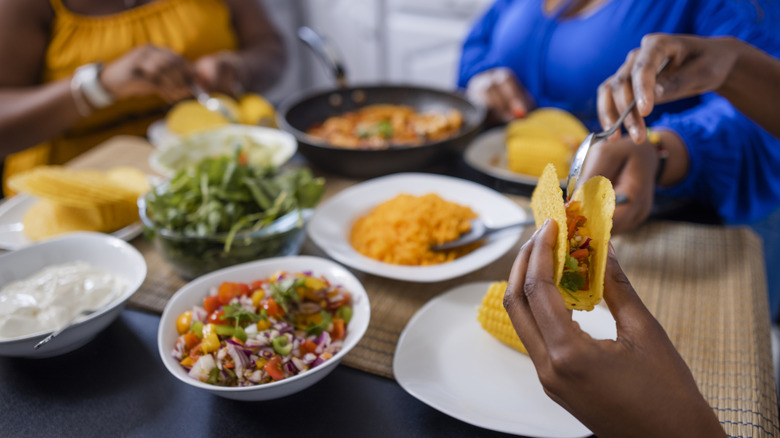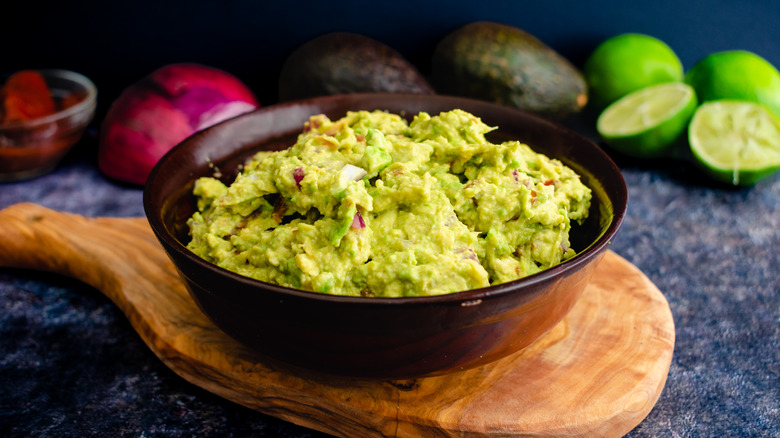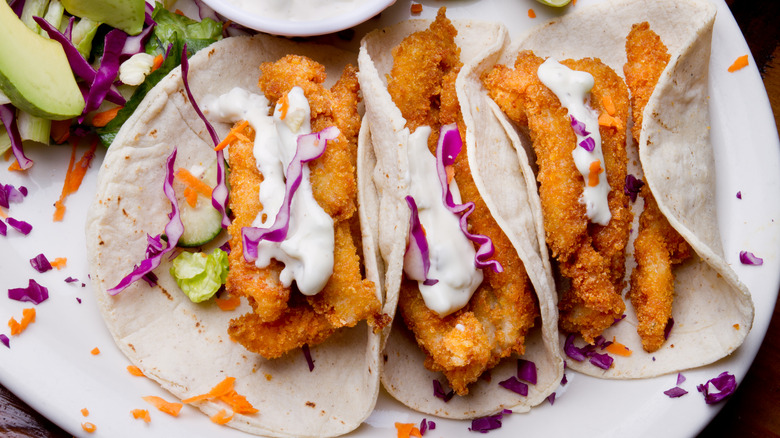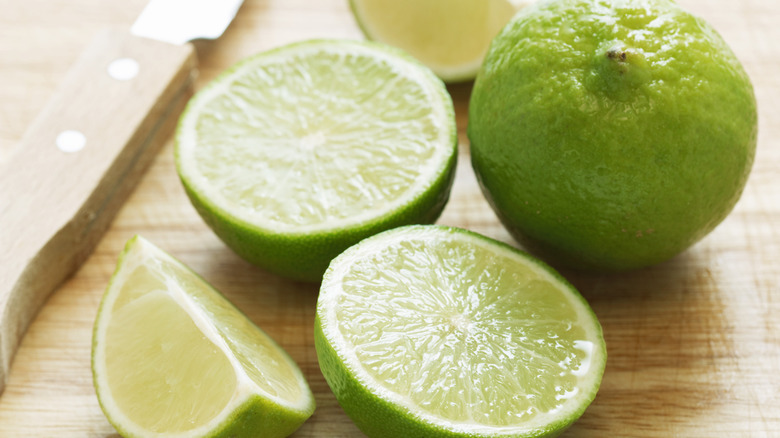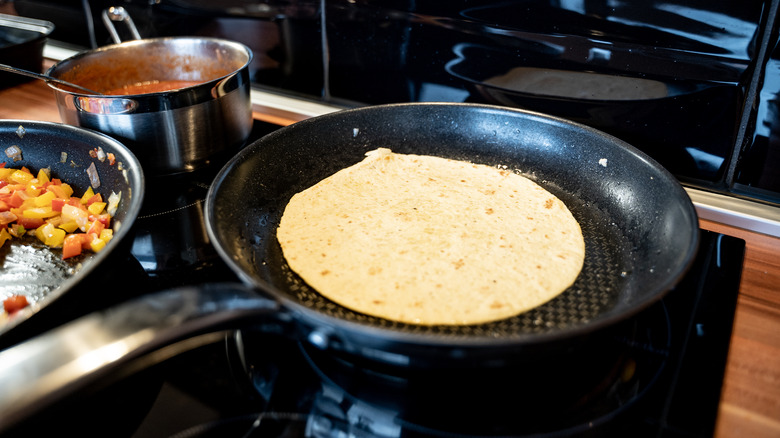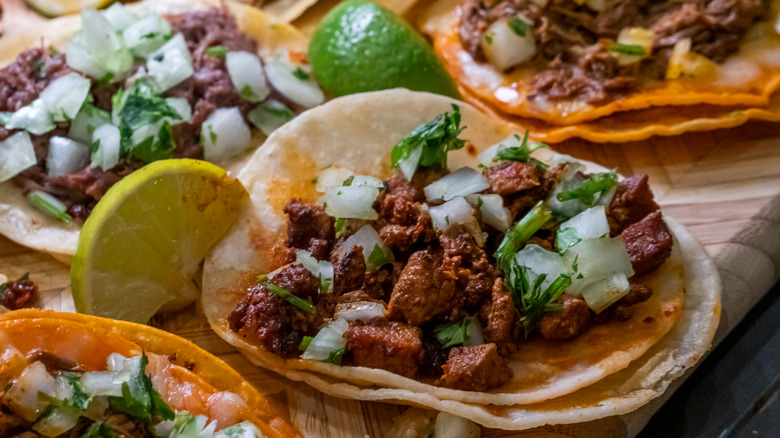14 Common Mistakes Everyone Makes When Cooking Tacos
It's hard to find folks who don't like tacos — but it's even harder to find folks who make them correctly every time. For such a simple-looking food, the humble taco is an item that's very prone to being made incorrectly. Throughout this popular Mexican food's history, people have been using the wrong fillings, tortillas, and flavors.
One of the main challenges with tacos is how compact they are: Their main selling point, which is that they're a food that offers a lot of flavor in a tiny package, is also their main stumbling block. Too often, people overfill their tacos, making what should be a small, handheld item into something unwieldy and clunky. Elsewhere, people use the wrong flavors entirely, or prepare their ingredients incorrectly, leaving their tacos underpowered, or with taste clashes that can't be rectified. An opposite issue can occur when people try to do too much with their tacos' flavors, putting in over-complicated versions of dishes that should be simple, leaving you with a handful of food that's just too intense. Luckily, with our top tips, you'll never make these mistakes again.
1. Using a tortilla made with the wrong ingredients
The type of tortilla you choose can make or break your taco. These small flatbreads usually use either flour or corn as their primary ingredient. Both corn and flour tortillas are perfectly valid for tacos (although not for other Mexican foods, interestingly – the difference between tacos and tostadas, for example, is that a tostada should never be made with a flour tortilla). However, tortillas will give your taco a vastly different flavor and texture. If you use the wrong one, you will ruin your meal.
Corn tortillas have an earthier flavor than their flour-based siblings, and usually have a slightly firmer, slightly mealy texture. This helps them serve as a flavor contrast in Baja fish tacos, where they balance the light sweetness of the fish and provide a robust shell to house the delicate flesh. They also work excellently with the sweet-savory notes in tacos al pastor. Flour tortillas, conversely, are more common in Northern Mexico, and have a sweeter flavor and chewier texture. They're also slightly stronger and more pliable than corn tortillas, making them a great choice for breakfast tacos, which contain heavier ingredients and therefore need more support.
2. Overfilling your tacos
Tacos are all about balance. This is, unfortunately, something a lot of people have yet to learn — and this lack of understanding leads to countless people overfilling their tacos. This cardinal sin is the quickest way to ruin your hard work, as you'll find that the moment you bite into your taco, the toppings will spill out onto your hand and your plate.
The main thing to remember is that you should never add more than your tortilla can take, and to be as minimal as possible. Tacos fill up quickly, and you'll want to ensure you can fold your taco around your fillings completely, without them spilling out. One way to nail this is by making a "test taco," working with set measurements for each ingredient and seeing how it goes. If this test taco feels too full, reduce the ingredients you're putting into each one, and consider making a larger number of smaller tacos. Don't be tempted to leave certain ingredients out, though, as the key to an excellent taco is having an abundance of different flavors in one bite.
3. Using the same type of salsa with every filling
We've been getting salsa wrong this whole time. What non-Latin folks think of as salsa (a combination of chopped tomatoes, lime juice, onion, and fresh herbs) is just one of many different types. This salsa, known as pico de gallo, certainly has a place on tacos, but using it in favor of some other styles will leave them tasting the same every single time, and will result in your tacos not being as good as they can be.
Instead, get to grips with the other taco styles. Salsa taqueria is one of the primary salsas used for tacos, and is usually way spicier than pico de gallo, thanks to containing arbol chiles. This salsa is cooked and blended into a smooth, pourable consistency. Salsa de aguacate can also be used on tacos. It gives you a bright contrast. This salsa is made with tomatillos and avocados, imbuing it with notes and a balance of acidity and creaminess that works against the meatier flavors of your fillings. Don't confuse this salsa with guacamole, though. While both contain avocados, salsa de aguacate is thinner and looser, whereas guacamole is thick and chunky.
4. Buying a premade hard shell
When to use a hard shell is one of the biggest questions novice chefs have when making tacos. If you want a hard shell, you should feel at liberty to use one — as long as you don't buy a premade one. While taco purists might turn their noses up at hard shells, they provide a deliciously crunchy flavor and a texture contrast to your soft ingredients. Granted, they may be impractical and less pliable, but they're fun.
The issue is that premade hard shells don't taste great. Too many of them have a flat, artificial flavor, which can ruin the hard work you've put into your fillings. They can also be too thin, meaning they shatter in your hands. So, if you want something crunchy, you should make your own crispy taco shells in the microwave. You just have to bend your tortillas around a round object, like a mug, and microwave them for a minute. Your tortillas will crisp up nicely. This is a great way to avoid using additional fat when making hard-shell tacos, and will give you a thick, sturdy, crunchy vessel.
5. Forgetting to marinate your proteins
Tacos should be quick to assemble and eat, but some of their ingredients shouldn't be quick to prepare. Okay, sure, you can fry up some ground beef or fish in a few minutes and throw it into a taco shell, but doing this will seriously limit the amount of flavor you get. When making tacos, your proteins should always be marinated for a good length of time to allow flavors to seep into the meat and develop, giving each bite more intensity. This is a mistake everyone makes with fish tacos in particular, but it's just as true for pork, beef, chicken, or shrimp tacos.
When marinating your meat or seafood, remember to strike the right balance of fats, acid, and seasoning. You can also make marinades without fat, provided you have ingredients that will still tenderize the meat. For super-easy marinated meat, try making Coca-Cola carne asada. Just crack a can of Coke and combine it with some herbs and spices, throw in your steak, and leave it for 24 hours. Coca-Cola's acidity helps to soften the beef's proteins, while its sweet notes give it a caramelized, deep flavor.
6. Using yellow onions with your tacos
Onions are everywhere in tacos. Not only are these vegetables used as ingredients in salsa and guacamole, but they're also used as a topping in themselves, often scattered over the meat to give the tacos a bright flavor and moreish crunch. If you're using yellow onions, though, you may be inadvertently ruining your meal. Yellow onions are commonplace in American cooking, but when raw (as they're often used on tacos) they can have a complex, somewhat overwhelming flavor. When cooked, they tend to turn gently sweet.
Instead, try to find white onions. White onions are the allium of choice in Mexican cooking, and they have a direct, clean flavor, which gives your food a slight astringency without overpowering things. Remember that yellow and white onions look very similar, particularly when they're peeled, so pay attention to their color. Yellow onions have a slightly brown, paper skin, and a gentle golden tinge to the edible part of the vegetable. White onions, on the other hand, will be white throughout, including on their exterior.
7. Forgetting about your layers
Layering tacos may seem simple, but placing your fillings in the wrong order can completely ruin them. Placing heavier ingredients on top of lighter ones can unbalance your taco, and cause them to fall out, leaving you with a handful of raw vegetables and salsa. Putting your liquid ingredients in first, meanwhile, can cause them to leak out. This can also result in a lack of adequate flavor in each bite, wasting your hard work.
When filling your tacos, you should always start with your meat or seafood. These are usually the heaviest objects and are also some of the loosest. Placing them at the bottom gives your taco a good base weight, ensures they don't fall out, and distributes their flavor well. Your cheese should go on top of your meat, especially if you're looking for a good melt, as the heat from your proteins will help to soften it. Then, add your vegetables, and top everything with salsa, sour cream, or guacamole. While this order tends to work well for any tacos, a nifty trick (if you're using lettuce) is to keep it as a full leaf and place it in first. Lining your tacos with lettuce will stop them from leaking.
8. Using too many of the wrong ingredients
Tacos are a pretty versatile food, and you can place lots of ingredients inside them and still have them taste good. There are some ingredients, however, that just don't belong in tacos – or in Mexican cuisine in general. Cumin, for example, is a common spice that makes its way into tacos that shouldn't be there in the first place. It's not that cumin isn't present in Mexican cooking, but it's used far more sparingly than Americanized versions of the same recipes would have you believe. While it has a subtle flavor when mixed with other spices, too much of it can be overwhelming, and ruin the taste dynamics of your meal, so use it very sparingly.
Another ingredient you should watch out for is paprika. Again, paprika isn't absent from Mexican cuisine, but it can find its way into some recipes where it really shouldn't be used, like in guacamole or pico de gallo. When you add paprika to these foods, it takes away from all their freshness and gives them an unnecessarily spicy flavor that ruins them. Instead, use only fresh ingredients in your toppings, and save your paprika for your marinades.
9. Making your guacamole too complicated
Guacamole is many people's favorite part of a taco. Creamy, verdant, and wholesome-tasting, guacamole gives an all-important contrast to your spicy proteins and zippy salsas. Unfortunately, it's easy and tempting to overcomplicate guacamole and throw in too many additional ingredients, like spices, cream, pepper, or even hot sauce. When you do this, you lose all of your guacamole's subtlety and turn it into an addition that distracts instead of compliments.
Therefore, you should focus on making your guacamole as simple as possible. Classic guacamole is a fairly simple affair. It's made by combining avocados, chopped onion, cilantro, and lime juice. Chopped jalapeño peppers are also a common feature for a touch of heat, while chopped garlic can give it a little savoriness and tang. That's all you need for a banging guac, apart from a pinch of salt to bring it all together. Adding bottled, jarred, or dried ingredients can ruin its flavor and its texture. Ground spices, in particular, can give it a gritty mouthfeel and an unbalanced taste.
10. Adding too much cheese
For many people, cheese is the most important part of a taco. However, those people likely aren't following traditional recipes, or consuming tacos the way they were meant to be eaten. While mountains of cheese have become commonplace in American or Tex-Mex taco recipes, in traditional Mexican tacos, cheese doesn't feature at all. The focus is instead on the taco's fresh and zippy flavors, which come from the proteins, vegetables, and salsa. If cheese does feature, it's added to bring everything together and to add a touch of creaminess that balances the heat.
So, steer clear of covering your taco in cheese — not only will it distract from your other flavors, but it's not the traditional way. Having said this, adding cheese to your taco is a matter of personal preference, and if you want to throw some in, go for it. Just be mindful of how it might affect your other flavors. You should also remember that you can vary the type of cheese you use. Rather than sticking cheddar or mozzarella on your taco, go for cotija, a crumbly Mexican cheese that tastes like feta.
11. Not pairing your toppings with your protein
It's easy to make tacos the same way every time you cook them, regardless of what protein you use. But you should remember that failing to match your toppings with your protein will give you an unbalanced, imprecise flavor. Certain toppings may go with beef or pork but will match less well with fish or shrimp. If you pair the wrong things, you'll end up with tacos that don't achieve their potential.
It's always best to think about what kind of flavors will complement your protein, and go from there. With fish tacos, for example, you want to avoid heavy, spicy flavors and instead focus on toppings that provide a brightness that complements the delicate protein. A fresh, crunchy cabbage slaw can work well with cod or other flaky white fish, and a sprinkling of corn can provide a pop of sweetness. For stronger-flavored proteins, like carne asada, consider using toppings that offer your meat a counterpoint. This is where cheese can be useful: A touch of cotija cheese can give your tacos a salty creaminess that stops the meat from becoming the dominant flavor.
12. Skipping the lime wedge
There's a reason why tacos are often served with a wedge of lime — and it's not just for appearances. Lime is one of the most important flavors in Mexican cuisine, and it adds a much-needed acidity to countless dishes, including tacos. You'll often find a lime wedge station at taco bars, and lime juice is used in guacamole, pico de gallo, other salsas, and meat marinades.
Make sure you're not skipping that lime wedge station, though. Lime juice has a slightly different flavor impact when it's squeezed over tacos instead of added to its core ingredients and hitting your food with a spritz before eating it will make all the difference. When you add fresh lime juice to food, it intensifies the flavors instantly, giving it a citrusy brightness that makes everything taste better. It also adds a pop of moisture, making your taco juicier and easier to eat. As everything is about balance when it comes to tacos, though, make sure you don't add too much fresh lime juice. You don't want to flood your taco with acidic liquid and make it unpleasant to eat, or risk altering the flavors produced by your hard work.
13. Forgetting to heat your tortillas
You can make the best fillings ever for your tacos, but everything can go downhill at the very last minute. Tortillas are notoriously prone to drying out due to their large surface area and thinness, and they can turn from pliable to brittle very quickly. When you go to fold them, this can mean that they crack in half, instead of delicately encasing your fillings, and all of your hard work can be for nothing.
However, you can avoid a cracked taco by warming the tortilla shell first. Heating tortillas allows the starches inside them to soften and re-gelatinize, giving them that soft, pliable texture you're looking for. There are several ways to warm up a tortilla, and your method will change depending on whether they're flour or corn. For corn tortillas, it's best to warm them in a hot skillet, which gives them an even, slow heat and lightly toasts them while also softening them up. Flour tortillas also warm well in a hot pan, but they can also be heated in the microwave. Just make sure you only blast them for a few seconds at a time, as they can turn from soft to overly heated and brittle very quickly.
14. Not double-stacking your tortillas
If you've ever wondered why tacos from a street food truck come with two tortillas layered on top of each other, it's not just because it looks good. Using two tortillas helps vendors give their food a little extra protection, and prevents the fillings from leaking everywhere if one of the tortillas splits. The second tortilla also gives you something a little more solid and concrete to hold onto and makes your meal that extra bit of filling. As a bonus, it also gives you an extra piece of bread to mop up any delicious juices that spill into your food container.
Somehow, though, this practice hasn't translated to homemade tacos — and we think that's a huge shame. Using two tortillas when making your tacos at home gives your food extra substance, costs very little, and requires virtually no effort. It's a particularly good idea if you're serving your tacos outside or at an event where people are standing up and walking around, to give them that extra sense of security in their food. It also allows you to add a little extra into each taco without fear of them splitting, and that can only be a good thing, right?
